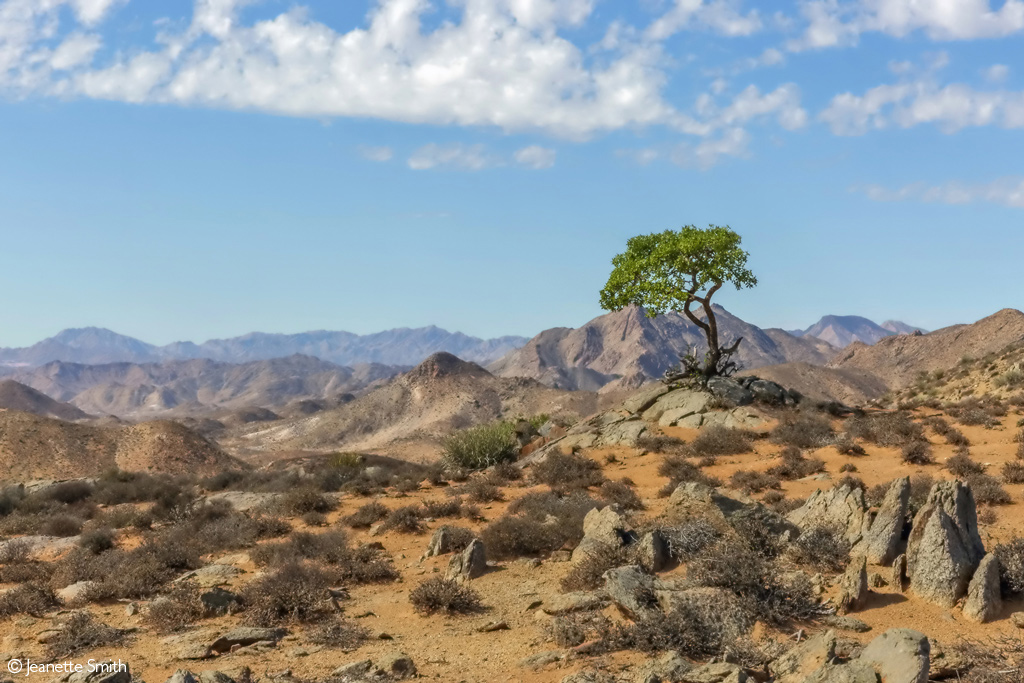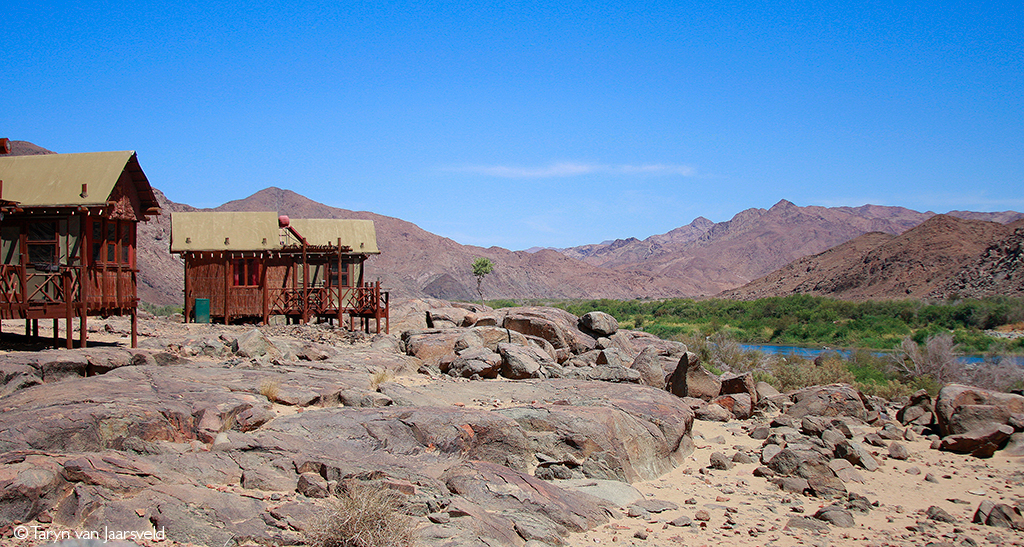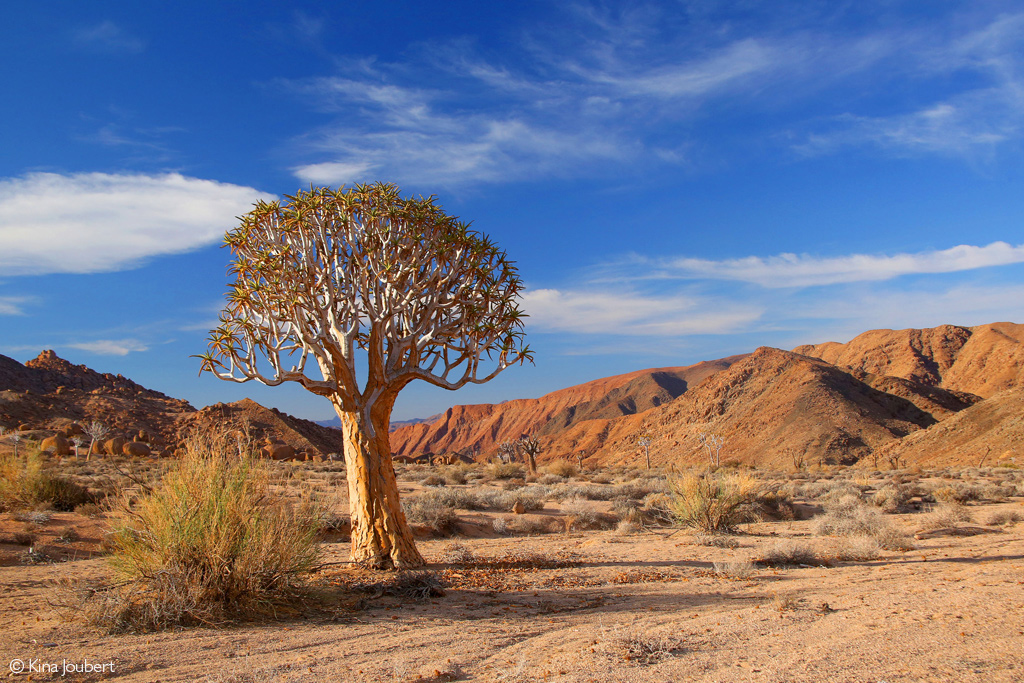
Lose phone connectivity, find peace


In the mirage-like desert setting of |Ai|-Ais Richtersveld Transfrontier Park, the unearthly shapes of strange trees lean longingly north towards the blazing sun. At a distance, they look uncannily like people, and they were once – or so the Nama legend goes. When fierce conflict drove the defeated Nama tribespeople out of more fertile lands in Namibia, they fled to the boulder-strewn desert of the south. Yet for some, the grief and yearning proved insurmountable, and they stopped to gaze back toward their beloved homeland. The gods took pity on these lost souls and turned them into “halfmens” trees (“half-human”, half-plant) to be forever consoled with their last view of home.
These eldritch plants are just one of the many ecological oddities of the rugged and seemingly inhospitable |Ai|-Ais Richtersveld Transfrontier Park. From an unparalleled array of succulents and an unusual subspecies of zebra to a river oasis and spectacular canyon views, it is a land for adventurous souls and enthusiastic naturalists. With an emphasis on self-sufficiency and wilderness appeal, the park is a place to lose phone signal and find peace beneath the dazzling expanse of the Milky Way.

|Ai|-Ais Richtersveld Transfrontier Park
As the name suggests, |Ai|-Ais Richtersveld Transfrontier Park straddles the border between South Africa and Namibia. The South African Richtersveld National Park and the Namibian |Ai|-Ais Hot Springs Game Park combine to protect over 6,000 km2 (600,000 hectares) of mountainous, arid habitat. The border between the two countries follows the sinuous curves of the sluggish Orange River – the longest river in South Africa and the only permanent water source in the entire region. On the South African side, the UNESCO Richtersveld Cultural and Botanical Landscape World Heritage Site is contiguous with the southern section of the national park. This vast area is communally owned and managed by the semi-nomadic Nama people, many of whom still follow the day-to-day traditions of their forefathers.
It takes time for the eye to adjust and appreciate the sharp geology and haunting beauty of this corner of Africa. At first glance, it is a remote desert that appears almost surrealistically harsh, baked hard under the searing sun, with some areas receiving less than 50mm of rainfall each year. Yet nature, in its indomitable manner, always finds a way, and the sharp quartz fields, plunging valleys, and sandy plains are bursting with endemic life for those who know where (and when) to look.

Much of this life is centred around the Orange River valley, an oasis of green where even Cape clawless otters are occasionally spotted frolicking in the murky water. Away from the river, the region’s fauna and flora are sustained by the thick mists rolling off the nearby Atlantic Ocean, floating life-giving water inland to be soaked in and supped up by thirsty desert dwellers. The Nama people call these mists “Ihuries” or “malmokkies”, and they provide a vital supplement to the scarce rains. Though the timing and amount vary, these rains usually arrive in winter over the park’s western section. They, in turn, are followed by an explosion of colour as flowers emerge to drape the landscape in a multi-hued blanket.
The allure of the almost alien landscape is coupled with the thrill of transcending the frills and fancies of modern life. To visit is to humble oneself in a vast and silent wilderness, untamed and all but untouched. It offers the chance to truly vanish “off the grid” – to drive for hours without another person in sight, to picnic on the banks of the Orange River and pitch a tent beneath the inky sky.


Sticks and stones
Strange though it may seem, rocks and plants are the superstars of the |Ai|-Ais Richtersveld Transfrontier Park experience. Some of the fascinating geological formations date back billions of years, with subsequent layers of rock displaying the history of the Earth’s epochs in an enormous geographic diorama. Massive granite boulders the size of buildings and streaks of blinding white Rosyntjieberg quartzite speak to the power of the ancient forces that shaped the very foundations of our planet. (Indeed, one particular formation even appears to bear the mark of a giant handprint, earning it the name Hand of God.) Moreover, the Namibian side of the park is home to the largest canyon in Africa – the Fish River Canyon (more on this later).

In keeping with the topographical theme, the plant life here is equally hardy and rugged, though nonetheless beautiful in its own way. The botanical hotspot of the Richtersveld is home to thousands of plant species, of which over 30% are believed to be endemic, and some may even be undiscovered. The |Ai|-Ais Richtersveld region is also widely acknowledged by experts as home to the richest array of succulents.
Aside from their poignant mythology, the spikey halfmens trees (Pachypodium namaquanum) are iconic survivors found nowhere else. These rare plants grow during the winter months, facing north to take advantage of available sunlight, and when it rains, the tips are adorned in a headdress of crimson flowers. Equally striking are the towering shapes of the quiver trees (Aloidendron dichotomum), jutting into the sky against the barren backdrop. Charming little rock-like succulents of the Conophytum genus pebble the ground alongside chubby botterboom plants (Tylecodon paniculatus). Botanically, no other desert in the world supports such an abundance of life.

Though the floristic displays somewhat overshadow the animal life, there are several species of antelope in the park, including grey rhebok, gemsbok, steenbok, klipspringer and kudu, as well as records of elusive caracal and leopard. Keen-eyed visitors may also be fortunate to spot some of the small herds of Hartmann’s mountain zebra – a rare subspecies distinguishable by a well-developed dewlap and stripes extending the entire length of the leg.

Richtersveld National Park
The South African portion of the Transfrontier park consists of several campsites, a network of 4×4 tracks and several seasonal hiking trails. The main entrance to the park can be found at Sendelingsdrift, which acts as the unofficial capital of the park. Here, visitors will find a shop, a swimming pool, the only fuel station, and well-appointed basic chalets with electricity: the last vestiges of civilisation before entering the wilds of the park. There is also a border post here, with a pont available to transport vehicles across the Orange River to the Namibian side of the park.
De Hoop and Richtersberg campsites are positioned on the lush banks of the Orange River, making them ideal for families. The river is crocodile-free, so unsupervised rafting and swimming are permitted, perfect for plunging in to cool off and wash away the day’s dust. Kokerboomkloof campsite lies away from the river, pressed against some of the most exquisite rock formations in the park. And for those that blanch at the thought of erecting a tent and cold showers, Tatasberg and Gannakouriep wilderness camps have chalets with solar-powered lights and gas geysers for the showers.
During winter, visitors can opt for overnight hiking trails ranging from one to three nights in the park. The company of an expert guide is highly recommended, but this is a visceral way to experience the park, encountering an amphitheatre, waterfall, gorges, Tswaies mountains, and springs along the way.

|Ai|-Ais Hot Springs Game Park
Most of the activities and accommodations on the Namibian side of the park are centred around the Fish River Canyon. The name |Ai|-Ais means “burning water” in reference to the springs at the southern end of the canyon. Here, travellers can soak tired muscles and soothe sore joints in the thermal baths.
The canyon is Africa’s largest natural gorge, created by the Fish River, cutting deeply into a plateau over 600 million years. It reaches 160km long, up to 27km wide and around 550 metres deep in some sections. Panoramic views are a given, but it is also one of Namibia’s most popular hiking areas, with visitors opting to explore (or, for some very enthusiastic athletes, run) the entire length of the canyon. (Hiking the canyon must be booked in advance, and permission will only be granted on receipt of a medical fitness clearance.) Within the gorge, hidden caves hide ancient rock art, some dating back over 25,000 years.


Explore & stay in |Ai|-Ais Richtersveld
There is a particular breed of camper for whom no challenge is too great. These are the people with hiking boots practically welded to their feet, equipped with every camping convenience, who can change a wheel with the skill of an F1 pit crew and erect a tent with equal efficiency. |Ai|-Ais Richtersveld Transfrontier Park is the perfect destination for such intrepid explorers. However, this is not to say that those with less experience should be intimidated; it is simply a matter of preparation.
The winter months, from around May until August/September, offer the best time to visit, both for the chance to witness the short flowering season and because the temperatures are slightly more bearable. This is, after all, a desert, and summer temperatures can peak over 50˚C before plunging towards freezing at night. Route planning is essential, as is a GPS to ensure that the planned route is followed. Throw in two spare wheels, plenty of fuel and an excess of drinking water, and you’re all set to explore the moonscape of the park from top to bottom. Remember not to leave any valuables outside overnight, as the malmokkies may blow in overnight!

Final thoughts on |Ai|-Ais Richtersveld
There is an undercurrent of magic in |Ai|-Ais Richtersveld Transfrontier Park, which makes it possible to believe that perhaps strange plants were men once and that giant hands played a role in shaping the landscape. The improbable biodiversity in this beautiful but harsh landscape is infinitely fascinating, offering the opportunity to embrace Africa in all her weird and wonderful ways.
To comment on this story: Login (or sign up) to our app here - it's a troll-free safe place 🙂.![]()






